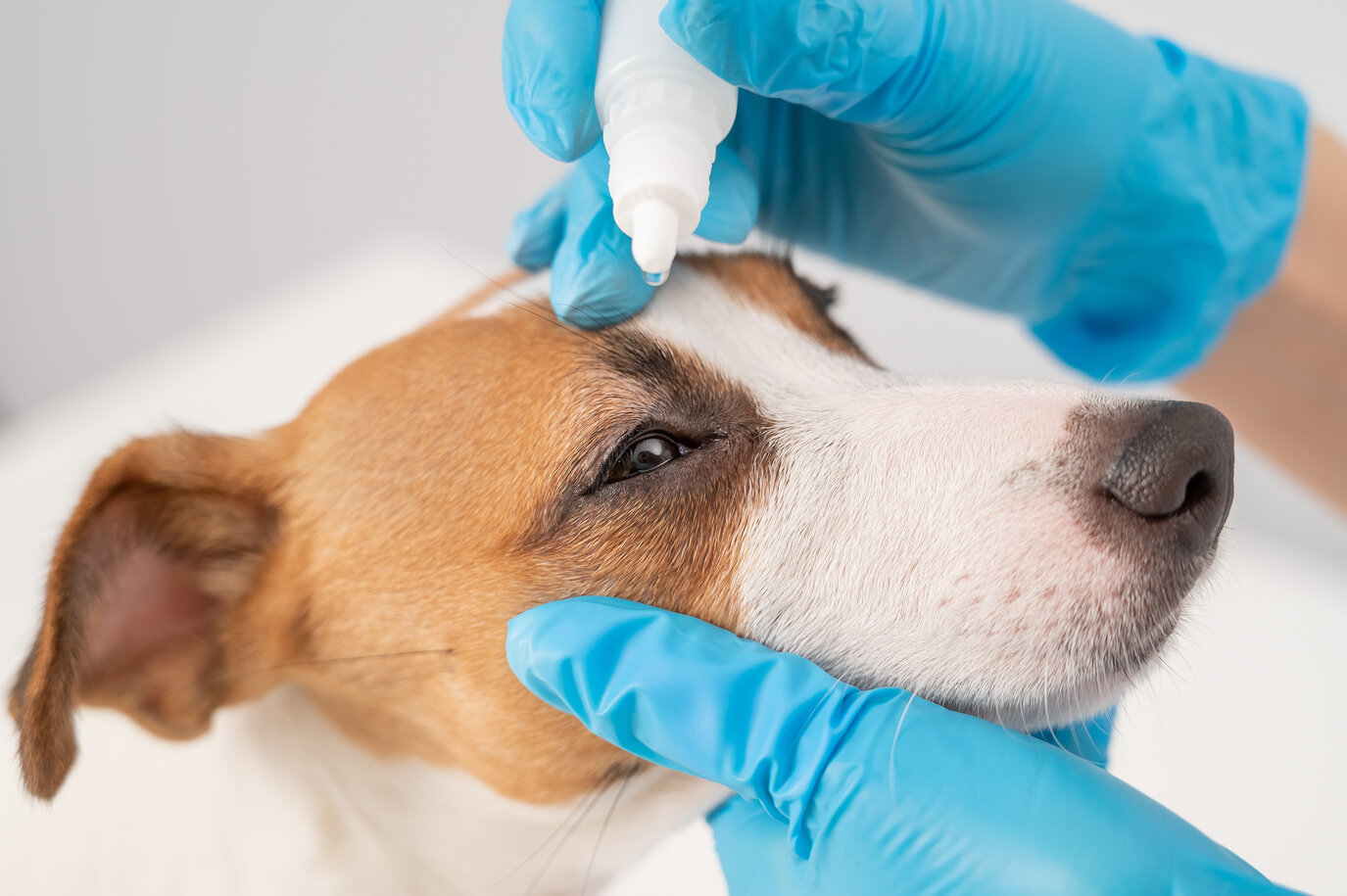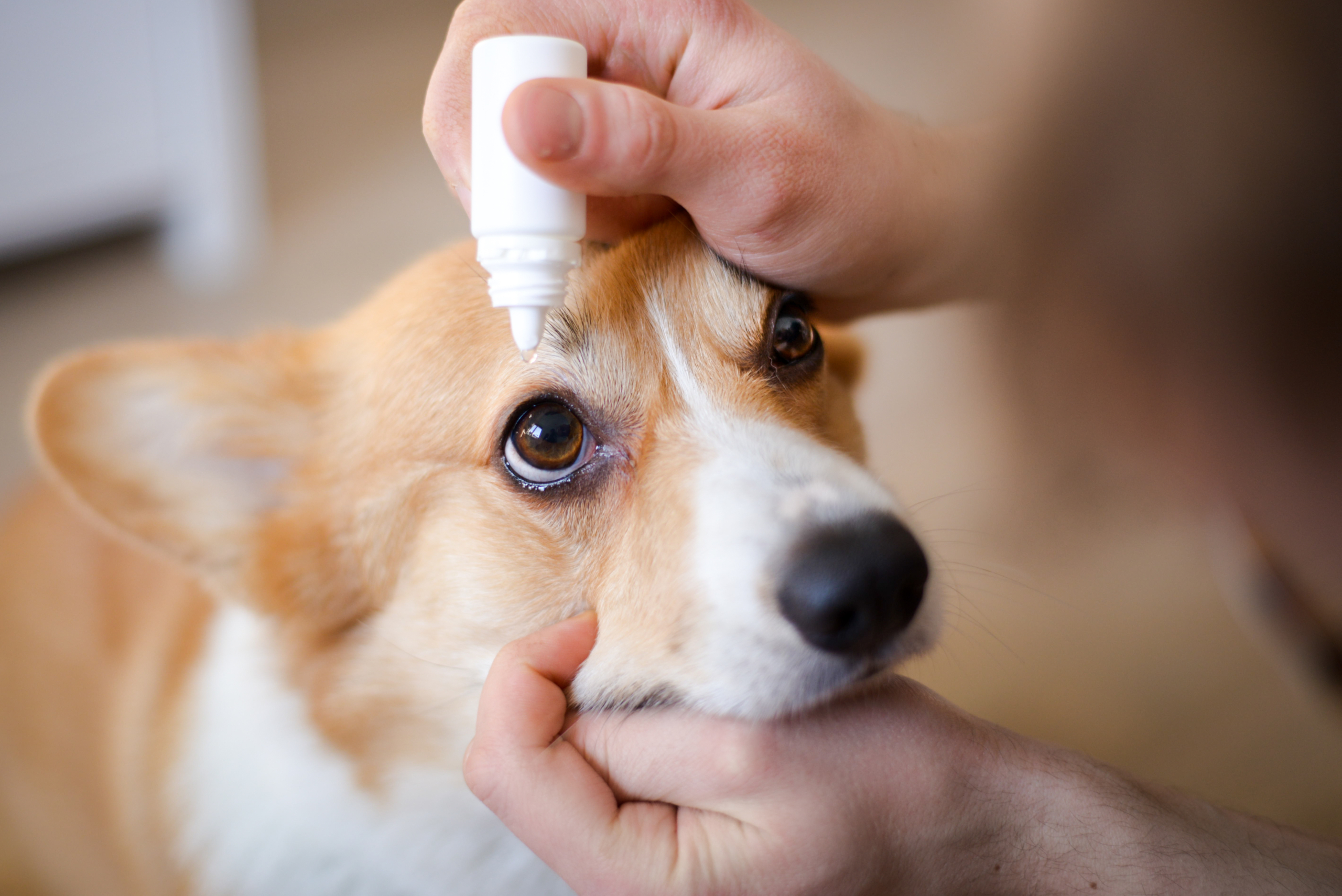The canine eye is much more resilient than a lot of people would expect to trauma, but this is still one of the most at-risk parts of the dog’s body. For this reason, corneal ulcers are quite the common reason for a visit to the vet.
While common, corneal ulcers should never be treated as a general situation that does not require veterinary or medical intervention. If the ulcer does not heal properly, the dog’s visual capabilities can be affected. Below, we will take a look at what a corneal ulcer actually is, what causes it, and how the condition may be treated.
What Is the Cornea of a Dog’s Eye?
The cornea, simply put, is the thin membrane that covers the forward-facing part of the eyeball. The membrane is completely transparent, almost like a window that protects the inner structures of the eye. The full cornea is about half as thick as a dime.
The dog’s cornea, much like a human’s cornea, is made up of different layers: the outer layer of epithelium, the interior layer of stroma, and the Descemet membrane at the deepest point. All three layers of the cornea are clear, making it impossible to discern between them with the naked eye. In order to examine the cornea, veterinarians use special pigmented eye drops with a green dye that highlights cells of specific layers of the cornea.
What Is a Corneal Ulcer?
Corneal ulcers are abrasions (sores) of the outer surface of the eye that protects the pupil, iris, and aqueous humor. Medically, corneal ulcers may be referred to as ulcerative keratitis. The abrasion causes inflammation, swelling, and can be slow to heal depending on the depth of the trauma. The ulcers in a dog’s cornea can range in severity from superficial to deep, depending on which layers of the cornea are injured.
Types of Corneal Ulcers in Dogs
Corneal ulceration can be superficial or a deeper problem that reaches into the corneal stroma, and sometimes all the way into the Descemet’s membrane. Here is a more thorough explanation of some of the types of corneal ulcers that dogs can have.
Superficial Ulcers
Superficial ulcers are sometimes referred to as superficial corneal abrasion or corneal erosion, and they affect only the epithelium layer. Superficial corneal ulcers are the easiest to treat and often do not require medical intervention to heal properly. However, topical antibiotics for the corneal surface may be vet-recommended until the ulcer heals.
Stromal Ulcers
Stromal ulcers affect the corneal stroma and can be much more threatening to the eye and the dog’s comfort level. The stroma is actually laced with nerves, which means damage to this layer of the cornea can bring about significant pain for the dog. Stromal ulcers take longer to heal than superficial corneal abrasions, and medical intervention with antibiotic eye drops is often a must to prevent infection.
Descemetoceles and Perforations
Ulcers that reach into the Descemet’s membrane are referred to as descemetoceles. When an ulcer actually goes completely through the Descemet’s membrane, this is referred to as corneal perforation.
Both descemetoceles and perforations may need to be surgically treated in an effort to preserve the eye, even though an aggressive effort to medicinally manage the problem may suffice for some dogs. Serious complications, such as vision loss and a need to remove the eye are more common with these types of ulcers.
Indolent Ulcers
Indolent ulcers, which are also referred to as spontaneous chronic corneal epithelial defects (SCCEDs), are non-healing ulcers that are usually caused by trauma. These ulcers are more common in older dogs, most often diagnosed around eight or nine years of age.
Even though by definition an indolent ulcer is superficial, sometimes, an indolent ulcer will actually get infected and affect the stroma. With this particular type of ulcer, improper healing can be to blame; the surface layer epithelium can actually be loosely attached to the underlying stroma.
How a Corneal Ulcer Occurs
Corneal ulcers in dogs can occur for several reasons, even though the biggest causative factor is usually some type of trauma to the dog’s eye. A dog’s eye may sustain trauma by a direct, blunt hit to the eye, foreign material under its eyelid, and even just by scratching with its own paws and nails.
A few other causes of corneal ulcers in dogs include:
- Illness or disease
- Lacking tear production
- Eyelid rolling or inability to close the eyelids
- Chemical burns
- Eye infections
- Facial nerve paralysis that affects eyelid movement
Some dog breeds can actually be more prone to corneal ulcers than others due to the shape of their eyes and the surrounding lids. For example, breeds with shorter noses and prominent eyes that seem to protrude a bit from the face like Pugs and Boxers, are more likely to sustain corneal ulcers.
Signs and Symptoms of a Corneal Ulcer in Dogs
One of the good things about corneal ulcers is the fact that most dog owners will readily recognize that something is wrong with their dog’s eye so they can seek veterinary care. A few signs and symptoms during the initial stages of a corneal ulcer include:
- Ocular discharge
- Squinting
- Sensitivity to light
- Watery eyes
- Pawing at the eyes
- Holding the eye closed
- Redness or inflammation of the eye
- Film development over the eye
Usually, dogs will show signs that their eye is injured or causing problems a lot during the first few days after the trauma occurs.
How Does a Corneal Ulcer Affect Your Dog?
Dogs with corneal ulcers may be affected in different ways depending on the severity of the condition. Sometimes, a surface-layer abrasion won’t seem to make much of a difference to the dog or the dog’s ability to see and get around. However, deeper abrasions can be painful and have a higher likelihood of affecting the dog’s vision.
Even though trauma to the eye is assumed to always be painful, this may not be the case with every corneal ulcer. While the issue can be recognizable upon visual inspection, injury to the corneal surface may only cause some slight discomfort, so a dog may not be in pain or show any major signs of distress.
Unfortunately, however, some corneal ulcers can be painful. As noted above, abrasions that go deeper than the corneal epithelium can be extremely uncomfortable for the dog. The vet may offer pain-relieving eye drops because of this.
Can a Dog Go Blind from a Corneal Ulcer?
Dogs can lose their vision to a corneal ulcer, especially if the condition is left untreated or if the proper steps are not taken to promote healing. For example, if the dog has a stromal ulcer, which carries a high risk of infection, and the condition is left untreated with antibiotic drops and gets infected, the chance the dog will lose its sight is high.
Another important factor, a scar on the surface of the cornea that develops during the healing process can lead to corneal opacity. This makes part of the eye appear as if it has clouded over, but it also makes it impossible for light to properly get to the optic nerve. Therefore, the dog’s visual capacity can be affected. In some cases, the right treatments during the healing process can help deter heavy scar formation.
Corneal opacity caused by scarring after an ulcer should not be confused with corneal dystrophy. Corneal dystrophy also causes opacity, but this is a result of some kind of genetic malfunction that interferes with how the dog’s body metabolizes fat. Fatty deposits can collect in the eye and cause similar cloudiness that impedes visual capacity over time.
Typical Corneal Ulcer Dog Treatment
Treatment for corneal ulcers in canines depends on the type of ulcer diagnosed. General corneal abrasions may need no treatment at all; the mild abrasions may heal on their own within a few days. Nevertheless, medication may be used as a preventive measure to prevent an ophthalmic infection. Some of the more typical methods of treating corneal ulcers include:
- Antibiotic eye drops
- Topical antibiotic ointments
- Eye drops with a pain reliever
When surgery is necessary to treat a corneal ulcer, a few different procedures may be used. For example, corneal diamond burr debridement surgery is a procedure performed with a diamond burr that gently removes the damaged corneal tissue to promote proper healing.
Regenerative Care for Canine Corneal Ulcers
Treating corneal defects is not an easy feat; so many things can inhibit the healing process and cause problems for the dog’s vision for the long term. Ideally, treatment would help the corneal tissue regenerate and repair itself with little disruption to the dog’s vision. Therefore, a more modern inclusion tactic in the treatment of corneal ulcers is using regenerative solutions.EyeQ Eye Drops from Vetrix is an easy way to offer regenerative care to the dog’s eye. These amniotic eye drops utilize innate growth factors and other components that modulate inflammation, offer just enough lubrication for protection, and promote healing by encouraging cellular growth. To find out more about EyeQ Eye Drops and corneal ulcers in canines, be sure to download the Corneal Ulcer Quick Guide.
 Keratoconjunctivitis sicca (KCS), often referred to as dry eye, is inflammation of the cornea and surrounding tissues due to inadequate production of tears. Tears are necessary to lubricate the cornea and remove debris or any infectious agents that come in contact with the eye. The tear film is a mixture of mucus, fatty liquid, and water.
Keratoconjunctivitis sicca (KCS), often referred to as dry eye, is inflammation of the cornea and surrounding tissues due to inadequate production of tears. Tears are necessary to lubricate the cornea and remove debris or any infectious agents that come in contact with the eye. The tear film is a mixture of mucus, fatty liquid, and water.

